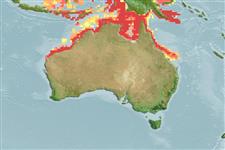分类 / Names
俗名 | 同种异名 | Catalog of Fishes(属, 种) | ITIS | CoL | WoRMS | Cloffa
Elasmobranchii
板鳃亚纲 (鲨鱼与 鱼) (sharks and rays) >
Rhinopristiformes (Shovelnose rays) >
Rhinidae (Wedgefishes)
Etymology: Rhynchobatus: Greek, rhingchos = snout + Greek, batis, -idos = a sting ray (Raja sp.) (Ref. 45335); palpebratus: Name from Latin 'palpebra' meaning eyelid, refers to the dark, eyebrow-like marking on the supraorbital membrane.
More on authors: Compagno & Last.
Environment: milieu / climate zone / depth range / distribution range
生态学
海洋 居于水底的; 深度上下限 5 - 61 m (Ref. 76954). ; 5°S - 23°S, 113°E - 154°E (Ref. 114953)
Indo-West Pacific: Eastern Indian Ocean and South-West Pacific; northern Australia and Papua New Guinea (Ref. 114953).
大小 / 重量 / 年龄
Maturity: Lm ? range ? - ? cm
Max length : 262 cm TL 雄鱼/尚未辨别雌雄; (Ref. 114953)
A poorly known benthic species that occurs in shallow water on the continental shelf. Presumably feeds on bottom-dwelling fishes and crustaceans. Males sexually mature at 103 cm TL (Ref. 114953).
Life cycle and mating behavior
成熟度 | 繁殖 | 产卵场 | 卵 | 孕卵数 | 仔鱼
Compagno, L.J.V. and P.R. Last, 2008. A new species of wedgefish, Rhynchobatus palpebratus sp. Nov., (Rhynchobatoidei: Rynchobatidae), from the Indo-West Pacific. In Last, P.R., White, W.T. & Pogonoski, J.J. (eds.): Descriptions of New Australian Chondrichthyans. CSIRO Marine and Atmospheric Research Paper no. 22. (Ref. 76954)
世界自然保护联盟红皮书 (Ref. 130435: Version 2024-2)
临近濒危 (NT) (A2bd); Date assessed: 03 December 2018
人类利用
工具
特别资料
下载 XML
网络资源
Estimates based on models
Preferred temperature (Ref.
123201): 24.6 - 28.8, mean 27.6 °C (based on 504 cells).
Phylogenetic diversity index (Ref.
82804): PD
50 = 0.5049 [Uniqueness, from 0.5 = low to 2.0 = high].
Bayesian length-weight: a=0.00372 (0.00163 - 0.00845), b=3.11 (2.91 - 3.31), in cm total length, based on LWR estimates for this (Sub)family-body shape (Ref.
93245).
营养阶层 (Ref.
69278): 3.6 ±0.6 se; based on size and trophs of closest relatives
Fishing Vulnerability (Ref.
59153): Very high vulnerability (90 of 100).
